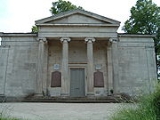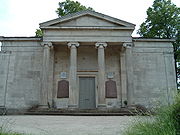
York Cemetery, York
Encyclopedia
York Cemetery is a cemetery located in the city of York, England. Founded in 1837, it now encompasses 24 acres (97,000 m2) and is owned and administered by The York Cemetery Trust with support of the Friends of York Cemetery. It is situated on Cemetery Road in the Fishergate
area of York. It has approximately 28,000 graves, over 17,000 monuments, 6 of which are Grade II listed. The chapel is a Grade II* listed building while the gatehouse, gate and railings are Grade II. The architect of these buildings and the grounds was James Pigott Pritchett
.
The Cemetery became an overgrown and derelict wilderness. Then in June 1984 the roof of the chapel gave up its unequal struggle against the elements and collapsed bringing down part of the rear wall with it. This single event stimulated a group of local people to take the action, which led to the formation of York Cemetery Trust, a registered charity. After two and a half years of planning, negotiation and fund-raising, the Crown Commissioners sold York Cemetery to the Trust for a nominal sum. On 13 February 1987, the Trust became the owners of the new freehold of the whole site with the responsibility of continuing the burial business, using the site for educational purposes and restoring the chapel and gatehouse.
Now a small staff of permanent employees, assisted by many volunteers who contribute in many ways, help to maintain and develop the wild and beautiful 24 acres (97,124.6 m²) site, rich in local history, genealogy and ecology as well as ensuring that it can still continue its original purpose as a burial place for the citizens of York.

Fishergate
Fishergate is one of the centre wards of York, England. It is situated directly south of the city walls, on the east bank of the River Ouse, north of Fulford. On its north west corner is the confluence point of the Foss and the Ouse. This area is protected from floods by the Foss Barrier...
area of York. It has approximately 28,000 graves, over 17,000 monuments, 6 of which are Grade II listed. The chapel is a Grade II* listed building while the gatehouse, gate and railings are Grade II. The architect of these buildings and the grounds was James Pigott Pritchett
James Pigott Pritchett
James Pigott Pritchett was an architect of London and York whose practice stretched from Lincolnshire to the Scottish borders.-Personal life:...
.
History
The York Public Cemetery Company was formed in 1837 to provide better burial facilities for the citizens of York - whatever their station in life - than those offered by the overcrowded parish and non-conformist graveyards in the city, . At first it had to compete with the other graveyards in the city, but, because of their unsatisfactory condition, they were all closed by an Order in Council in December 1854. From 1855 then, until the 1940s, the cemetery expanded to its present size of 24 acres (97,124.6 m²) by buying all the adjacent land that was available. As a result it prospered and paid good dividends to its shareholders. By the 1960s, however, with the cemetery nearly full, it became clear that it was no longer financially viable and that the high returns previously enjoyed by the shareholders could not be sustained. With prospects of very little income to pay wages and cover the maintenance of the site the company, in June 1966, went into voluntary liquidation. When the process was completed in 1979, there was nothing of commercial value left, only the land containing over 28,000 graves, 17,000 monuments and two listed buildings in an advanced state of disrepair. The abandoned site devolved to the Crown.The Cemetery became an overgrown and derelict wilderness. Then in June 1984 the roof of the chapel gave up its unequal struggle against the elements and collapsed bringing down part of the rear wall with it. This single event stimulated a group of local people to take the action, which led to the formation of York Cemetery Trust, a registered charity. After two and a half years of planning, negotiation and fund-raising, the Crown Commissioners sold York Cemetery to the Trust for a nominal sum. On 13 February 1987, the Trust became the owners of the new freehold of the whole site with the responsibility of continuing the burial business, using the site for educational purposes and restoring the chapel and gatehouse.
Now a small staff of permanent employees, assisted by many volunteers who contribute in many ways, help to maintain and develop the wild and beautiful 24 acres (97,124.6 m²) site, rich in local history, genealogy and ecology as well as ensuring that it can still continue its original purpose as a burial place for the citizens of York.

Notable interments
- Thomas Cooke, (1807–1868),optical instrument manufacturer
- John PhillipsJohn Phillips (geologist)John Phillips FRS was an English geologist.- Life and work :Philips was born at Marden in Wiltshire...
, (1800–1874), geologist - John Kenrick, (1788–1877), classical historian
- William HewsonWilliam Hewson (theological writer)William Hewson was a theological writer and curate in the Church of England during the Victorian age.-Life:Hewson, son of William Hewson of 7 Tottenham Court New Road, clerk in a bank, was born on 12 April 1806; baptised at St. Margaret's, Westminster, on 28 December in the same year; and entered...
, (1806–1870), theological writer. - James Pigott PritchettJames Pigott PritchettJames Pigott Pritchett was an architect of London and York whose practice stretched from Lincolnshire to the Scottish borders.-Personal life:...
, (1789–1868), architect. - Joseph TerryJoseph TerrySir Joseph Terry was an English industrialist.Terry was born in York, England, and educated at St Peter's School, York. In 1854, he took over his father’s confectionery business, together with his two younger brothers....
, (1828–1898), confectioner. - John PettyJohn Petty (Primitive Methodist Minister)The Revd. John Petty was a 19th century author and Primitive Methodist Minister, and the first Governor of Elmfield College. He was born in Salterforth, Yorkshire and died at Elmfield School, York. Memorial services were held at the little Stonegate Chapel on Sunday 26 April and on the following...
, (1807–1868), Primitive Methodist Minister.
External links
- York Cemetery Main Website
- York Cemetery Genealogy Website - cemetery chapel

